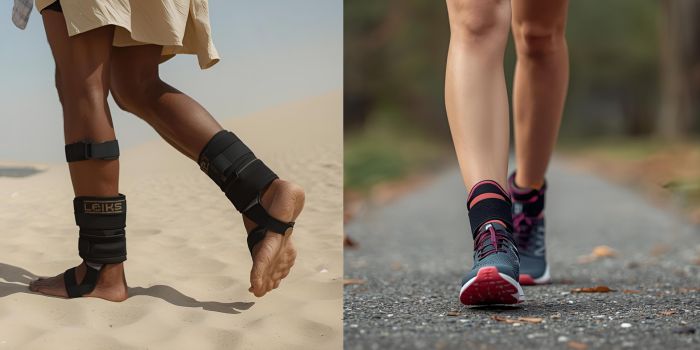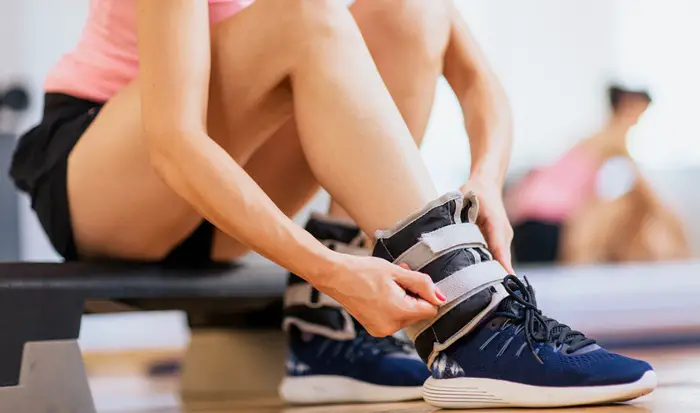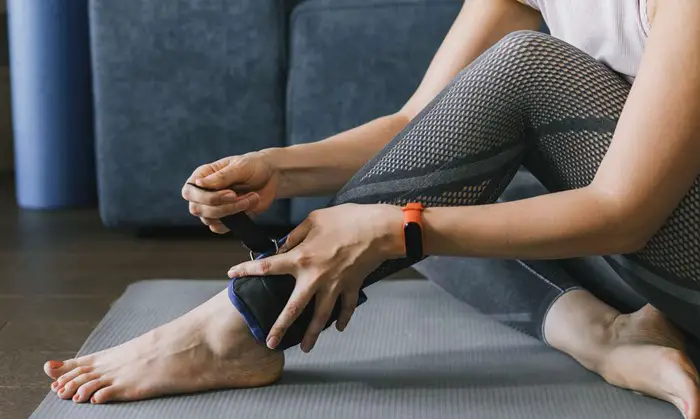
When it comes to staying active, most of us know that walking is one of the simplest and most effective forms of exercise.
It’s low-impact, easy to stick with, and doesn’t require fancy equipment. But if you’ve ever felt like your daily walks could use a little extra challenge, you’re not alone.
That’s where ankle weights come into play. They’ve been gaining popularity recently as people look for creative ways to get more out of their workouts without drastically changing their routine.
The question is—are they actually helpful, or could they be doing more harm than good? Let’s explore.
What Are Ankle Weights?
As the name suggests, ankle weights are small weights that strap securely around your ankles, usually just above the joint. They’re designed to add resistance to your movements while you walk, jog, or even go about daily tasks.
These weights come in different sizes and levels of heaviness, so you can start light and gradually increase as your strength improves.
Some are slim enough to slip under your clothes, meaning you can wear them on a casual stroll or even while running errands without anyone noticing.
The idea is simple: by carrying a little extra load with every step, your muscles have to work harder. Over time, this added resistance can help strengthen your legs, build endurance, and even tone muscle.
But to get the best out of them—and avoid any strain—it’s important to know how they actually work when you use them for walking.
How Do Ankle Weights Work While Walking?
If you’re wondering how effective ankle weights really are, the answer lies in resistance. Once strapped on, every step you take becomes a little more demanding because your legs are pushing against added weight.
This resistance turns ordinary walking into something closer to a strength-and-cardio combo workout.
As you move, you’re engaging more than just your feet—you’re calling on your glutes, hamstrings, quadriceps, and calves to put in extra effort. The result? Stronger legs, improved muscle tone, and greater overall power.
Since your body is working harder with each step, your heart and lungs benefit too. In other words, you’re blending cardiovascular training with resistance training in one go—making ankle weights a surprisingly simple tool to level up your walking routine.

Benefits of Using Ankle Weights While Walking
Due to the wide range of benefits offered by ankle weights exercises, these are frequently recommended by most chiropractors, physical therapists, occupational therapists, trainers, and athletic coaches in rehabilitation exercises and sports training.
So, what are some of the primary benefits of wearing ankle weights while walking or running? Some prominent advantages include the following:
1- Burn more calories –
If you’re performing your cardio in order to lose weight and get in shape, wearing leg weights is a great way to do exactly that.
By wearing ankle weights, the cardio becomes harder, so the body is forced to work harder. When it works harder, it needs more energy.
This energy isn’t conjured up from thin air, it instead comes in the form of calories from stored body fat.
By using ankle weights to perform your cardio, you will burn off more calories and will, therefore, burn off more body fat in the process.
2- Tone the legs and overall physique –
Another great benefit associated with ankle weights is the fact that they allow you to tone your legs while performing cardio.
Ankle weights provide additional resistance in the form of the weight you choose to utilize.
This additional weight means that each step is essentially being utilized like any other repetition in the form of free weights in the gym.
The more steps you perform, the harder the muscles in the legs are being worked, and the more muscle you will be able to build.
Over time, by wearing reusable leg weights you will work more muscles in your legs and you will build and tone more muscle as a result.
Now, be under no illusions, ankle weights won’t suddenly shape and tone your leg muscles overnight, but if you consistently wear them as part of your running and walking, you will notice gradual improvements in lower-body muscle tone, size, and strength after a week or two.
Ankle weights can also be a good addition to your workout routine when you are specifically targeting the areas like glutes, thighs, knees, and even abs.
Various different ankle weight exercises for the knee, thighs, and glutes can be performed to make your physique look great. If you are not using these leg weights you are already missing those great workouts.
3- Increase stamina and endurance –
The fourth benefit associated with wearing ankle weights is the fact that wearing them will help you to boost your stamina and your endurance.
The main reason for this is the fact that the additional weight you are wearing around your ankles will provide additional resistance and will require you to generate extra force and power when walking or running.
This means that you are conditioning your body to be more efficient when dealing with heavier weights than it is used to. Over time, this will result in noticeable increases in stamina and endurance.
This is one of the main reasons why there are so many endurance athletes now utilizing leg weights as part of their regular training regimes.
Put simply, walking or running while wearing ankle weights will help you to improve your stamina and endurance, making you a lot fitter from a cardiovascular perspective.
Many people are now using ankle weights in the water while swimming. It is also beneficial for dancers as they can use them while dancing too.
The added resistance is also great for muscle toning in the legs, plus there’s the added bonus of there being no impact placed on the joints.

Risks and Side Effects of Ankle Weights When Walking
With the smooth, we also have to take the rough, which is why we are now going to be looking at a few common risks and side effects associated with using ankle weights.
1- Trip hazard –
As we touched upon briefly a little further up, as ankle weights have to be fastened securely, there is sometimes the risk of the straps becoming undone and loose.
This would present a very serious trip hazard, especially while running.
If you imagine running along down a steep hill, and suddenly having your ankle weight become undone, causing you to trip over, you can see how potentially dangerous that would be.
Some ankle weights can be fastened with Velcro to keep them fastened tighter and more secure, but again, there is always the risk of them becoming undone and you tripping over them while wearing them.
2- Stress your joints –
As beneficial as resistance ankle weights are when you wear them while walking or running, there is always the risk that they will place additional stress upon your joints.
The weight exerts more force, which is absorbed by the joints and can cause damage to them over time. As mentioned, if you suffer from pre-existing joint complaints, ankle weights could potentially make things worse.
If you happen to twist your ankle or turn incorrectly, there is also a greater risk of injury, so again, that is something that you should bear in mind.
3- Aggravate previous injuries –
If you are already suffering from an existing injury, even if it is something fairly basic, there is always the risk that wearing ankle weights could put you at risk of aggravating that existing injury.
Say you previously damaged your Achilles tendon in your ankle, if you were to wear an ankle weight, this additional pressure placed upon the injury will come as a shock, and it may exasperate it and make the condition worse.
How to Use Ankle Weights – What Exercises Can You Do with Them?
To get the most out of ankle weights, it’s not just about strapping them on and heading out the door—you’ll want to use them correctly and safely. The first step is choosing the right weight.
If you’re a beginner, start light. An adjustable pair in the 5–8 pound range is usually ideal because it lets you begin with the lowest setting and increase gradually as you get stronger.
A common mistake is to go too heavy, too soon. While it might feel like heavier weights will burn more calories or build muscle faster, overloading your joints can actually lead to strain or even injury.
Think of ankle workout weights as a tool to enhance your workout, not replace it. Use them periodically rather than during every single walk or jog, and always listen to your body—especially if you already deal with joint issues.
Another important tip: make sure the straps are secure. Loose weights aren’t just distracting; they can also cause tripping hazards or muscle pulls. Keep them snug but comfortable so they stay in place while you move.
Now, the fun part—how to use them! Ankle weights are versatile and can add resistance to both lower- and upper-body exercises. Here are a few simple ways to incorporate them into your routine:
- Walking or jogging (outdoors or on a treadmill)
- Marching in place while standing
- Seated leg extensions – straighten and stretch your knees one at a time
- Seated knee lifts – raise your knees toward the ceiling for hip and core strength
- Knee-to-chest lifts – great for targeting the abs
- Plyometric moves – like jump squats or vertical jumps, for explosive power
- Lying leg raises – lift one or both legs toward the ceiling while lying on your back
Just remember: as you increase intensity with weighted ankle straps, your muscles are also being challenged to stabilize and balance more. To avoid exhaustion or overtraining, schedule weight-based sessions a few times a week and give your body enough rest in between.
DIY Making vs. Buying Adjustable Ankle Weights for Walking or Running
If you’re on a budget—or just enjoy a little DIY—making your own ankle weights at home can be a smart (and surprisingly simple) option. Not only does it save money, but homemade leg weights can also be customized to suit your fitness level.
Whether you want something super light for daily walks or a bit heavier for strength training, DIY solutions let you adjust the weight exactly as you like.
The best part? You don’t need fancy equipment. With just a few common household items, you can create effective DIY ankle weights that work almost as well as store-bought versions. Here’s a simple way to start:
- Grab a pair of old socks or fabric pouches – these will act as your weight holders.
- Fill them with household items like rice, beans, sand, or even coins. (Sand usually feels more comfortable and distributes weight evenly.)
- Secure the ends tightly with a knot, rubber band, or by stitching them shut to prevent spills.
- Attach them to your ankles using Velcro straps, strong elastic bands, or by tying them snugly with cloth strips.
- Test the fit – they should stay in place without sliding around, but not feel uncomfortably tight.
Now, if you want to skip all the hassle of making your own customizable DIY ankle straps at home, you can buy them online, as they are readily available at a very affordable price. Here are a few considerations you need to keep in mind.
How Heavy:
First of all, when you are planning to buy the weights for the workout you need to examine your strength level, goals, and present level of fitness.
Based on that determine how heavy you want your weights to be. In case you are not pretty sure about the resistance you want, you can start with the lightest option available.
The Comfort Level:
Secondly, you need to make sure that the weights you are buying are made up of high-quality comfortable material. Also, make sure that you choose the right fit that is neither too tight nor too loose.
It’s good to choose the one that comes with flexible adjustment capabilities and allows you to wear them comfortably on your body part (ankles or wrist) without getting the skin irritated or chafed.
Your Goals and Activities:
Remember that the pair of weights you need to consider significantly depends on the type of activities you are into.
If you want them just for walking you may need to get a different pair than as required by people who need them for dancing, physical therapy, or sports like gymnastics or basketball.
Also, if you want to use them in a swimming pool you will likely consider the one that is waterproof.
The Conclusion
Walking with ankle weights can definitely add an extra challenge to your workouts, helping to build strength, improve endurance, and tone your lower body. They’re simple, affordable, and versatile—but they’re not for everyone, and they need to be used wisely.
Going too heavy or using them too often can put unnecessary stress on your joints, so moderation and proper form are key.
If you’re looking to level up your walks, runs, or at-home workouts, leg weights or weighted ankle straps can be a great addition—just start light, listen to your body, and increase gradually. Used the right way, they’re a handy fitness tool that can help you get more out of every step.
